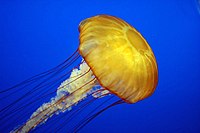
Seasonal and spatial variability of zooplankton diversity in the Poyang Lake Basin using DNA metabarcoding
Sign Up to like & getrecommendations! Published in 2022 at "Ecology and Evolution"
DOI: 10.1002/ece3.8972
Abstract: Abstract Freshwater ecosystems face multiple threats to their stability globally. Poyang Lake is the largest lake in China, but its habitat has been seriously degraded because of human activities and natural factors (e.g. climate change),… read more here.
Keywords: poyang lake; dna metabarcoding; zooplankton; using dna ... See more keywords

Critical role of parasite‐mediated energy pathway on community response to nutrient enrichment
Sign Up to like & getrecommendations! Published in 2022 at "Ecology and Evolution"
DOI: 10.1002/ece3.9622
Abstract: Abstract Parasites form an integral part of food webs, however, they are often ignored in classic food web theory or limited to the investigation of trophic transmission pathways. Specifically, direct consumption of parasites by nonhost… read more here.
Keywords: mediated energy; food; parasite mediated; energy ... See more keywords

The effects of hypolimnetic anoxia on the diel vertical migration of freshwater crustacean zooplankton
Sign Up to like & getrecommendations! Published in 2018 at "Ecosphere"
DOI: 10.1002/ecs2.2332
Abstract: Lakes and reservoirs worldwide are increasingly experiencing depletion of dissolved oxygen (anoxia) in their bottom waters (the hypolimnion) because of climate change and eutrophication, which is altering the dynamics of many freshwater ecological communities. Hypolimnetic… read more here.
Keywords: vertical migration; zooplankton; hypolimnetic anoxia; anoxia ... See more keywords

Local adaptation to UV radiation in zooplankton: a behavioral and physiological approach
Sign Up to like & getrecommendations! Published in 2020 at "Ecosphere"
DOI: 10.1002/ecs2.3081
Abstract: Ultraviolet radiation (UVR) is recognized as a driving force for phenotypic divergence. Here, we aim at assessing the ability of zooplankton to induce UVR tolerance and disentangle the relative importance of local adaptations behind the… read more here.
Keywords: zooplankton; tolerance; local adaptation; environment ... See more keywords

Bet-hedgers commit to the hedge: Zooplankton in ephemeral semiarid wetlands of tropical Brazil that widely spread risk.
Sign Up to like & getrecommendations! Published in 2023 at "Ecology"
DOI: 10.1002/ecy.4014
Abstract: Bet-hedging is an ecological risk-aversion strategy where a population does not commit all its effort towards a single reproductive event or specific environmental condition, and instead spreads the risk to include multiple reproductive events or… read more here.
Keywords: bet hedging; risk; zooplankton; tropical brazil ... See more keywords

The impact of calcium decline on population growth rates of crustacean zooplankton in Canadian Shield lakes
Sign Up to like & getrecommendations! Published in 2018 at "Limnology and Oceanography"
DOI: 10.1002/lno.10653
Abstract: Within the last decade, calcium decline has emerged as a stressor for many soft water lakes. A legacy of long-term acid deposition and logging, calcium decline has been implicated in the loss of large herbivores,… read more here.
Keywords: calcium; zooplankton; growth rates; calcium decline ... See more keywords

Seasonal and vertical dynamics in the trophic structure of a temperate zooplankton assemblage
Sign Up to like & getrecommendations! Published in 2019 at "Limnology and Oceanography"
DOI: 10.1002/lno.11161
Abstract: We determined the stable nitrogen isotope composition (δ15N values) and body size of taxonomic groups in a zooplankton community in the Cantabrian Sea (southern Bay of Biscay) to explore seasonal and depth (0–2000 m) variations in… read more here.
Keywords: zooplankton; production; trophic structure; size ... See more keywords

Can zooplankton on the North American Great Plains “keep up” with climate‐driven salinity change?
Sign Up to like & getrecommendations! Published in 2020 at "Limnology and Oceanography"
DOI: 10.1002/lno.11647
Abstract: The Great Plains of North America are projected to become more arid as the climate changes over the next century. Salinity levels for lakes in this region are linked to climate, suggesting that lakes will… read more here.
Keywords: zooplankton; dubia; climate; salinity levels ... See more keywords

Can small zooplankton mix lakes
Sign Up to like & getrecommendations! Published in 2017 at "Limnology and Oceanography"
DOI: 10.1002/lol2.10047
Abstract: The idea that living organisms may contribute to turbulence and mixing in lakes and oceans (biomixing) dates to the 1960s, but has attracted increasing attention in recent years. Recent modeling and experimental studies suggest that… read more here.
Keywords: zooplankton mix; mix lakes; zooplankton; small zooplankton ... See more keywords

Native and invasive zooplankton show differing responses to decadal‐scale increases in maximum temperatures in a large temperate river
Sign Up to like & getrecommendations! Published in 2020 at "Limnology and Oceanography"
DOI: 10.1002/lol2.10162
Abstract: It has been widely proposed that increasing global temperatures will promote the geographic spread of invasive species, yet few studies have examined the effects of increasing temperatures on existing populations of invaders. Here, we examine… read more here.
Keywords: zooplankton; differing responses; invasive zooplankton; native invasive ... See more keywords

Immunochemical methods for identification of prey in freshwater zooplankton
Sign Up to like & getrecommendations! Published in 2020 at "Limnology and Oceanography: Methods"
DOI: 10.1002/lom3.10366
Abstract: Large, predatory, non‐indigenous species such as the cladoceran, Bythotrephes longimanus, can have a profound effect on aquatic food webs, but determining the prey consumed by such species is problematic because they shred prey externally and… read more here.
Keywords: immunochemical methods; identification prey; zooplankton; methods identification ... See more keywords